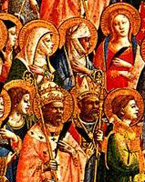
First Council of Constantinople (381)
The First Council of Constantinople is believed to be the Second Ecumenical Council by the Assyrian Church of the East, the Oriental Orthodox, the Eastern Orthodox and the Roman Catholics. It was called by Theodosius I in 381 and confirmed the Nicene Creed and dealt with other matters such as Arian controversy. The council took place in the church of Hagia Irene from May to July 381.
The Council re-affirmed the Nicene Creed and developed its definition of the place of the Holy Spirit in the Holy Trinity.
Four canons are agreed upon by all the Churches (three more by some):
The first canon is an important dogmatic condemnation of all shades of Arianism, also of Macedonianism and Apollinarianism.
The second canon renews the Nicene legislation imposing upon the bishops the observance of diocesan and patriarchate limits.
The famous third canon reads:
The Bishop of Constantinople, however, shall have the prerogative of honor after the Bishop of Rome because Constantinople is New Rome.
This canon was a first step in the rising importance of the new imperial capital, just fifty years old, and was notable in that it demoted the patriarchs of Antioch and Alexandria. Jerusalem, as the site of the first Church, retained its place of honor.
After the Great Schism (1054), in 1215 at the Fourth Lateran Council[10], Roman supremacy over the whole world was formally claimed by the new Latin patriarch. The Roman correctores of Gratian[11], insert the words: "canon hic ex iis est quos apostolica Romana sedes a principio et longo post tempore non recipit." (This canon is one of those that the Apostolic Roman See did not accept at the beginning and for a long time after.)
The fourth canon[12] declares invalid the consecration of Maximus of Constantinople, the Cynic philosopher and rival of Gregory of Nazianzus, as Bishop of Constantinople.




